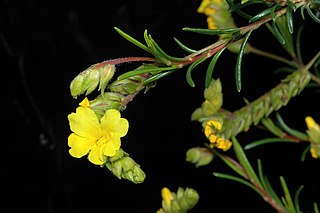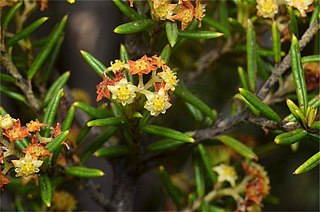
Pultenaea scabra, commonly known as rough bush-pea, is a species of flowering plant in the family Fabaceae and is endemic to south-eastern continental Australia. It is an erect or spreading shrub with hairy stems, heart-shaped leaves with the narrower end towards the base, and yellow and red, pea-like flowers.

Hovea acanthoclada, commonly known as thorny hovea, is a flowering plant in the family Fabaceae. It is an upright, prickly shrub with small dark green leaves and purple-blue pea flowers in winter and spring. It is endemic to the south-west of Western Australia.

Pultenaea densifolia, commonly known as dense-leaved bush-pea, is a species of flowering plant in the family Fabaceae and is endemic to southern continental Australia. It is a spreading or low-lying shrub with broadly egg-shaped, down-curved leaves and clusters of purple or yellow, red and purple flowers.

Eremophila weldii is a flowering plant in the figwort family, Scrophulariaceae and is endemic to Australia. It is a shrub with glabrous green leaves, small sepals and purple or lilac-coloured petals and it occurs in arid and semi-arid areas of Western Australia and South Australia.

Beaufortia puberula, commonly known as hairy-leaved beaufortia, is a plant in the myrtle family, Myrtaceae and is endemic to the southwest of Western Australia. It is a shrub growing to a height of about 2 m (7 ft) with hairy young leaves and heads of hairy, pink or red flowers during most of the year.

Pultenaea skinneri, commonly known as Skinner's pea, is a species of flowering plant in the family Fabaceae and is endemic to the south-west of Western Australia. It is a slender shrub with simple leaves, and yellow, red and orange flowers with red markings.

Leucopogon plumuliflorus is a species of flowering plant in the heath family Ericaceae and is endemic to the south-west of Western Australia. It is a weakly erect shrub with egg-shaped leaves and spikes of white or pinkish-white, tube-shaped flowers.

Goodenia hirsuta is a species of flowering plant in the family Goodeniaceae and is endemic to northern Australia. It is a hairy, prostrate to low-lying perennial herb with narrow egg-shaped leaves at the base of the plant, racemes of hairy yellow flowers and oval to elliptic fruit.

Pultenaea elachista is a species of flowering plant in the family Fabaceae and is endemic to southern Australia. It is an erect, spindly shrub with hairy foliage, oblong to egg-shaped leaves with a pointed tip, and yellow flowers with red or orange markings.

Pultenaea hartmannii is a species of flowering plant in the family Fabaceae and is endemic to an area around the border between New South Wales and Queensland. It is an erect shrub with hairy stems, oblong to triangular leaves with the narrower end towards the base, and yellow flowers with red markings.

Bossiaea neoanglica is a species of flowering plant in the family Fabaceae and is endemic to eastern Australia. It is a prostrate to low-lying shrub with sparsely hairy foliage, egg-shaped to more or less round leaves, and yellow and red flowers.

Gompholobium marginatum is a species of flowering plant in the family Fabaceae and is endemic to the south-west of Western Australia. It is a prostrate or low, spreading shrub with palmate leaves and uniformly yellow, pea-like flowers.
Gompholobium polyzygum is a species of flowering plant in the family Fabaceae and is endemic to north-western Australia. It is an erect or prostrate shrub with pinnate leaves each with sixteen to twenty-one pairs of leaflets, and yellow-orange and greenish, pea-like flowers.
Pultenaea vestita, commonly known as feather bush-pea, is a species of flowering plant in the family Fabaceae and is endemic to south-western continental Australia. It is an erect to prostrate, sometimes mat-forming shrub with elliptic to linear or lance-shaped leaves, and yellow and red, pea-like flowers.

Kennedia beckxiana, commonly known as Cape Arid kennedia, is a species of flowering plant in the family Fabaceae and is endemic to the south-west of Western Australia. It is a prostrate or twining shrub or a climber with trifoliate leaves and red and yellow, pea-like flowers.

Hibbertia spicata is a species of flowering plant in the family Dilleniaceae and is endemic to the west of Western Australia. It is a low, erect to spreading shrub with scattered linear leaves with the edges rolled under and yellow flowers with six or seven stamens on one side of two softly-hairy carpels, and a larger number of staminodes.
Pomaderris forrestiana is a species of flowering plant in the family Rhamnaceae and is endemic to south-western Australia. It is a low shrub with elliptic leaves, and small clusters of woolly-hairy flowers.

Lasiopetalum parvuliflorum is a species of flowering plant in the family Malvaceae and is endemic to the south-west of Western Australia. It is an erect, spreading shrub with hairy stems, oblong to linear leaves and green or cream-coloured flowers.

Spyridium daltonii is a species of flowering plant in the family Rhamnaceae and is endemic to Victoria in Australia. It is a shrub with softly-hairy branchlets, linear to narrowly elliptic leaves, and small groups of hairy, yellowish flowers.

Commersonia magniflora is a species of flowering plant in the family Malvaceae and endemic to Australia. It is an erect shrub with wrinkled, narrowly oblong to elliptic or egg-shaped leaves, and deep pink flowers.

















